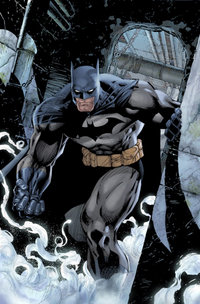Batman
The DC Comics superhero Batman (originally and still sometimes referred to as The Batman) is a fictional character who first appeared in Detective Comics #27 in May 1939. His "true" identity is Bruce Wayne, billionaire industrialist, playboy, and philanthropist. more...
Although the character was co-created by artist Bob Kane and writer Bill Finger, only Kane receives official credit for the character. Batman was, at first, just one of several characters featured in Detective Comics. He has since become the lead (or co-lead) character of a number of comic book series, including a number of titles featuring related characters (e.g. Robin, Batgirl).
Publication history
In early 1939, the success of Superman in Action Comics prompted editors at the comic book division of National Publications (later DC Comics, D.C. is short for Detective Comics, now a subsidiary of Time Warner) to request more superheroes for their titles. In response, Bob Kane created a character called "the Bat-Man". His collaborator Bill Finger offered such suggestions as giving the character a cowl instead of a simple domino mask, wearing a cape instead of wings, wearing gloves, and removing the red sections from the original costume. Finger wrote the first Batman story and Kane provided the art. Because Kane had already submitted the proposal for a Batman character to his editors at DC Comics, Kane was the only person given official credit at the time for the creation of Batman, and is still the sole creator listed to this day.
A number of other sources have been cited as inspirations for Batman's personality, character history, and visual design and equipment, including Zorro starring Douglas Fairbanks, 1926's The Bat, Dracula, The Shadow, Sherlock Holmes, Dick Tracy, Spring Heeled Jack and even the technical drawings of Leonardo Da Vinci.
The Batman was a breakout hit, with sales on Detective Comics soaring to the point that National's comic book division was renamed "Detective Comics, Inc." After one year, Dick Grayson/Robin (named after Robin Hood) was introduced based on Finger's suggestion to Kane that Batman needed a "Watson".
Kane, the more business-savvy of the Kane-Finger creative team, negotiated a contract with National, signing away any ownership that he might have in the character in exchange for, among other compensations, a mandatory byline on all Batman comics stating "Batman created by Bob Kane", regardless of whether or not Kane had been involved with that story at all. At the time, no comic books and few company-owned comic strips were explicitly credited to their creative teams. Bill Finger's contract, by comparison, left him with a monetary pittance and no credit even on the stories that he wrote without Kane. Finger, like Joe Shuster, Jerry Siegel, and many other creators during and after the Golden Age of Comic Books, would resent National for cheating him of the money and dignity that he was owed for his creations. By the time Finger died in 1974, he had never once been officially credited for his work. In comparison, Kane parlayed his official sole creator status into a low level of celebrity, enjoying a post-comic book career as a painter. Ironically, much of Kane's later comics work, and even some of his non-comics art, was written or illustrated by other, uncredited writers or artists, ghostwriting under Kane's name. However, Kane reportedly felt bad that Bill Finger wasn't receiving any credit for his contributions to the Batman character.
Evolution of the concept
In Batman's original comics, Batman stories were often presented in the tone of film noir and gothic horror films of the day, with a particularly grim emphasis; a few stories even present Batman making use of firearms, as well as showing little remorse over an enemy's death. Following this style, the body count in the first dozen or so published Batman stories was quite high.
This interpretation of Batman began to soften with the introduction of Robin in Detective Comics #38 in 1940, and in 1941's Batman #7, Batman was made an honorary member of Gotham City's police department. Batman's tone continued to stay lighter for the next several decades.
In Superman (1st series) #76 (1952), Batman first teamed up with Superman and learned his secret identity; following the success of this story, the separate Batman and Superman features that had been running in World's Finest Comics instead featured both together; this series of stories ran until the book's cancellation in 1986. The stories featured the two as close friends and allies, tackling threats that required both of their talents.
Starting in the mid-1950s, Batman's stories gradually became more science fiction oriented in tone, an attempt at mimicking the success of the top-selling Superman comics of the time. New characters such as Batwoman, Ace the Bat-Hound, and Bat-Mite (the latter two paralleling Krypto the Superdog and Mr. Mxyzptlk of the Superman titles) appeared. Batman also began having various adventures involving either odd transformations or dealing with bizarre space aliens. Batman was a highly public figure during the stories of the 1950s as well, regularly appearing at such events as charity functions, and also frequently appearing in broad daylight. In 1960, Batman also became a member of the Justice League of America, which debuted in The Brave and the Bold #28.
Editor Julius Schwartz presided over drastic changes made to a number of DC's comic book characters, including Batman in 1964's Detective Comics #327. Schwartz introduced changes designed to make Batman more contemporary and return him to more detective stories, including a redesign of Batman's equipment, the Batmobile, and his costume (introducing the yellow ellipse behind the costume's bat-insignia), and brought in artist Carmine Infantino to help in this makeover. The space aliens and characters of the 1950s such as Batwoman, Ace, and Bat-Mite were retired. This makeover soon became known as the "New Look" Batman. Julius Schwartz also created Aunt Harriet to live with Bruce and Dick. This influenced the campy Adam West Batman parody TV series in 1966, which ran until 1968.
Read more at Wikipedia.org





